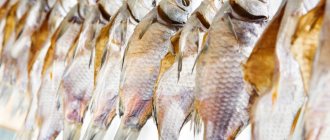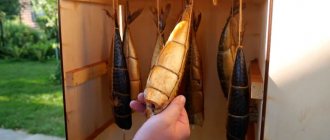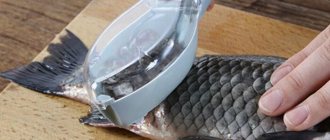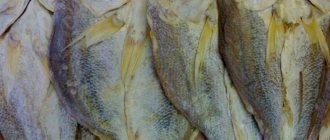Drying is a popular method of preparing river and sea fish. In this form, the product can be stored for a long time, which is especially convenient when there is no space in the freezer. It can be used as a snack or an ingredient for fish dishes. Dried fish is often offered to children who refuse to eat it fried or boiled.
In order for prepared fish to be stored for a long time, it is important to correctly select and prepare the carcass, as well as carry out preliminary salting and soaking. In this article we will figure out how to properly dry fish so that it turns out tasty and healthy.
Selection and preparation of carcasses
You can dry fish at any time of the year. However, in summer you will have to deal with a large number of insects if drying takes place outdoors. In winter, you cannot do without additional heat sources, and you also need to control air humidity. That is why many fishermen prefer to carry out drying and drying in the fall.
It is best to prepare fish for drying either in the spring before spawning or in the fall. At this time, it accumulates a large supply of fat, and the meat has a better taste. Fish caught in the first half of summer is in the process of recovery after spawning, its meat is tougher and fresher.
For harvesting, it is necessary to select only fresh carcasses that do not have damage to the scales. It is strictly forbidden to choose specimens with signs of staleness - unpleasant odor, softness and cloudy eyes.
Before salting, the fish must be thoroughly washed; gutting before drying is an optional step, depending on the chosen type of fish and taste. What is important to consider when choosing fish:
- In summer, the intestines of herbivorous fish species may contain large amounts of algae, while predators may contain small prey. This can lead to bitterness in dried meat.
- Large fish must be gutted; it is impossible to dry it completely at home. It is allowed to leave the swim bladder and eggs.
- Small specimens caught in the fall can be dried along with the offal. They will add a piquant taste to the finished product.
- You can dry any fish, but keep in mind that the meat of predators is drier and tougher. The varieties with a flat body reach readiness the fastest.
It is also possible to dry sea fish, even purchased frozen. Before drying, it must be defrosted, preferably in the refrigerator, to avoid sudden temperature changes.
Useful tips
It happens that during the drying process the fish turns out to be tasteless or spoils literally within a month. To protect your catch from such troubles, just adhere to the following recommendations:
- When laying out carcasses for salting, place the largest specimens on the bottom.
- String fish of the same size onto one fishing line, which will ensure uniform drying.
- A toothpick inserted into the abdomen will greatly speed up the process and make it more effective.
- If during storage the fish begins to smell musty, it is enough to rinse it in a weak saline solution and repeat the drying procedure.
- It is better to hang carcasses on the balcony after sunset. During the night, the fish will become weathered and will no longer attract insects.
- Some people advise drying fish without scales, but during the cooking process the product loses its aroma and becomes dry and tasteless.
- The best time to prepare the product is spring or autumn.
Where to store dried fish
The shelf life of the product depends on its storage conditions. You can wrap the fish in parchment or natural fabric and seal it in a plastic bag. To store, place in the freezer.
The condition of the packaging must be checked regularly. If condensation appears on the bag, it means the “cover” of the fish needs to be replaced. If you miss the moment, the product will become saturated with moisture and become damp.
By placing the finished carcasses in linen or paper bags and hanging them in a cool place, you can enjoy your favorite product for six months. If you store fish in a hermetically sealed jar, the product will not lose its beneficial and tasteful qualities for 5 months.
Salting fish
Salt allows you to extend the shelf life of dried fish and improves the taste of its meat. Salting the catch can be done in several ways:
- Dry. Place the prepared fish in a container with holes in the bottom (plastic box or basket). Arrange the carcasses in layers, sprinkle with salt. Cover with a lid and place a weight on top. It is important to place a bowl under the container where the juice will drain. Salting time – 1 week.
- Wet. The method is similar to the previous one, but the container must have no holes. Place a weight on top, for example a stone or a jar of water. Salting using this method lasts 3-4 days.
- Tuzluchny. You need to prepare a strong salt solution, the readiness of which can be checked using a raw egg - if it sinks, then the liquid is not salty enough. Place the fish in the solution for 2 days; the use of pressure is not necessary.
For pickling, it is best to choose an enamel container or stainless steel utensils. It is forbidden to use aluminum containers - they oxidize, which negatively affects the taste of the product. Particular attention should be paid to the load for oppression; you should not choose metal objects, since salt accelerates the corrosion process.
To salt the catch, it is recommended to choose coarse or iodized salt; you can additionally add bay leaf and black pepper to taste. The container with the workpiece should be stored in a cool and dark place where there should be no temperature changes.
You should not use fine extra salt - it is quickly absorbed into the meat, and it will be difficult to rinse the fish before drying. As a result, the finished product may be over-salted.
How to marinate fresh fish? Cold marinating
To marinate small fish, you do not need to gut it; for large fish, this condition is mandatory. There are two types of fish marinating: cold and hot.
1. Prepare the marinade: 200 milliliters of water, 100 grams of salt, 200 grams of sugar. Mix and dissolve in 300 milliliters of boiling water.
2. Cool.
3. Pour 500 ml of vinegar and boiled water into the brine.
4. Add one gram of bay leaf, one gram of dill, three grams of pepper, preferably allspice, one and a half grams of mustard grains.
5. Place the dish with the fish in the refrigerator for five days, first add onion rings and pour in the marinade (1:1). The onion turns out no less tasty than the fish itself.
Soaking and preparation for drying
Before you start drying the fish, you need to check it for readiness. To do this, press your finger on the carcass - a dent quickly appears on it, and the spine crunches when stretched. If there are no such signs, the catch should be salted for another 1-2 days.
If you do not soak the fish after salting, the meat will turn out very salty and tough. Before drying, the product must be thoroughly rinsed under running water, paying special attention to the gills and belly. Pour water into a container and place the catch in it according to the following rule: the fish should be soaked for as many hours as the number of days it was salted, plus one hour. Be sure to change the water at least 3-4 times.
Advice from experienced housewives
When preparing dried fish, we recommend taking into account the following nuances:
- The best time to prepare the product is autumn and spring, since during these periods the fish itself is fattier and turns out much tastier.
- To prevent wasps and flies from landing on the carcasses, we hang them out at night. This way, they will have time to weather and dry before the morning and will not attract insects. Additionally, you can coat the product with a mixture of sunflower oil and vinegar (3:1).
- If during soaking some carcasses floated, this “indicates” that they were poorly salted. They should be dried separately and also eaten first.
- You should not dry the product in the summer, because under the influence of high temperatures the carcasses will turn out bitter or completely rotten.
To properly dry fish at home and get a tasty and aromatic product, you need to follow all the main stages of its preparation, as well as follow our recommendations for preparing the product, salting it and drying it.
Designs for drying
To dry small fish in small portions, you can do without hanging:
- Lay foil on any horizontal surface (table, window sill, floor), and a layer of clean paper on top.
- Place the fish on the paper and cover it with a light cloth or gauze to protect it from flies.
- Turn the fish daily until cooked, change the litter if necessary.
With this method, the room will smell of fish; the product does not cook very quickly. Therefore, many people prefer hanging drying. Main methods:
- Stretched wire. It is best to choose a small section of stainless steel wire. Stretch it between supports indoors or outdoors. You can string fish through the eyes or gills, placing the carcasses at a distance of at least 1 cm from each other. In the summer, it is advisable to additionally hang tulle or gauze to protect against insects.
- Chalky. This method is suitable for drying fish in small batches. You need to take a stiff wire, bend one end into a loop and string 3-5 fish onto it. Form a hook at the second end, hang the prepared crossbar on a nail or hook on the wall.
- Frame. This design is suitable for those who dry regularly. To do this, you need to make a frame in the form of a cone, pyramid or parallelepiped from wood or rigid wire. Cover with mosquito net or gauze, install removable crossbars or hooks inside for tensioning the wire.
When hanging the fish by the tail, all the fat is retained in the carcass, which gives it a special aroma and taste. However, with this method the drying process is delayed, and fatty varieties cannot be used.
More information about making a drying frame can be seen in the video:
Drying time depends on the size of the fish, external conditions (humidity, wind, temperature), as well as the chosen method. Small specimens reach readiness in 4-7 days, large carcasses take up to 20 days to dry.
Sagging Ambassador
Used for fatty fish. Large representatives of fish are prepared and hung on rods. Then they are placed in a saline solution. The brine should be so salty that the raw potatoes float. The carcasses need to be placed so that they are not too squeezed against each other. After a week, the product can be removed from the brine and, after washing and drying, eaten.
If you catch a big catch in the summer heat far from home, you can do the following:
- Salt the fish carcasses in a large plastic bag.
- Bury the bag in the soil (it doesn’t matter whether it’s sand or earth). The burial depth is 0.7-1 m. The soil layer will serve as protection from heat and at the same time as oppression.
- To prevent moisture from dew or rain from penetrating inside the bag, you need to put a small bag over the neck.
If the fish carcasses are large in size, then they must first be gutted, wiped dry (no washing!), and cut off the head and tail. Rub the outside of each carcass. Sprinkle salt into all cuts and inside. Wrap in clean burlap. You can also use a cloth napkin. Wrap tightly with twine or bandage. Before cooking, the carcasses are soaked using milk or water. Then they cook - boil, stew, fry. The choice of option is to your taste. You can also eat it raw, seasoned like a herring.
Advice. If you catch a large catch in winter and freeze thoroughly on the way home, you should not salt such fish: after defrosting, the tissue structure is already damaged, so it picks up a lot of salt. Because of this, it is very difficult to catch the moment when the carcasses are salted and the fish can be significantly over-salted. In addition, when soaking and hanging, carcasses may disintegrate. It is best to process the catch that has survived freezing and thawing into stew.
Where can you dry fish naturally?
For high-quality drying of fish, moderate humidity, good ventilation and protection from sunlight are required. It is also important to properly organize protection from insects (flies and wasps); for this purpose, covering with an ordinary mosquito net or gauze is suitable. You can dry fish naturally in the following places:
- In the fresh air. You can choose any convenient hanging method, be sure to provide shelter from flies and a canopy from direct sunlight. Drying outside is only possible in summer and early autumn, depending on the region.
- In the attic. This room has excellent conditions for drying fish. It is important to carry out a wet cleaning first to remove dust and also make sure there is ventilation.
- In the cellar. Due to the weak air flow and high humidity in the basement or cellar, only bringing the fish to a ready-made state is allowed. Drying in this room is not recommended.
- On the balcony. Suitable for drying at any time of the year. In winter, warm glazing and the use of additional heat sources are required.
- In a residential area. You should not dry fish in a house or apartment because of the strong odor, which is difficult to get rid of. Residential premises may only be used to bring dried fish to the required condition.
The choice of drying location directly affects the speed of this harvesting method. It is best to dry the fish outdoors naturally, and then dry it indoors - in the kitchen, balcony or attic of the house.
How to dry it at home?
If you are going to dry fish outside of a closed area, then you should worry about protecting it from flies and other insects. If you do not do this, then larvae may appear in dried fish. It is advisable to first dip the fish in a vinegar solution.
Drying fish usually takes no more than a week, although this depends on the size of the fish and your preferences. Some people like it drier, some like it softer. Don't forget to cover the fish with gauze or mosquito net. If you dry it on the balcony, then it is not necessary to resort to such measures.
The way you dry your fish will determine the end result. Experts say that it is best to hang a fish by the eye. They say this is how the fish retains its flavor and becomes fattier. If you don’t like particularly fatty fish, we advise you to hang it by the tail. After a few days, the fish is ready to eat!
Using household appliances
The use of simple kitchen equipment can make drying fish much easier, and small specimens can be dried even without first hanging them. An oven is suitable for solving this problem:
- After soaking, dry the fish in a colander or on a paper towel.
- Place the prepared carcasses on a baking sheet in one layer, placing parchment underneath. Place in the oven.
- Start the oven in convection mode at a temperature of 40-50 °C. The door should be left slightly open.
- After 2 hours, turn the carcasses over and place foil on top of a baking sheet. Leave to dry for another 2 hours.
- After this, the fish must be cooled, passed through the eyes or gills onto a wire and dried for one day under natural conditions.
For drying, it is also possible to use an electric dryer, choosing only a closed model of the device (it is suitable for drying meat and fish). The process takes about 4 hours at a temperature of 70 °C.
Primary requirements
Before drying or drying fish, you need to decide how salty it should be.
Now we’ll talk about how much to salt fish for drying, and you can make this delight yourself at home or in the country. If the fish contains ten percent salt, then it is considered lightly salted; if it contains twenty percent or more, it is considered highly salted. The brine (the juice that the fish secretes, mixed with salt) is periodically drained to prevent bacteria from multiplying and spoiling the fish. Fish for drying or drying must be fresh and chilled. Only after this can you start gutting. Salting fish for drying is a very responsible matter. It is necessary to gut the insides so that microbes do not get on the meat.
Storage of the finished product
You need to dry fish according to your own taste, since you can eat both slightly dried and overdried meat. Typically, the drying process takes about 7 days for medium-sized specimens. Readiness can be determined by the condition of the scales - there are traces of fat on it, no salt. The skin should be tight, but it should come off easily. The meat of the finished dried fish is dense and translucent with a piquant taste; there should be no bitterness.
It is best to store dried fish in the refrigerator in a closed container - this allows you to preserve the freshness, taste and benefits of this product. Placement in a cellar, loggia or attic is allowed. For this purpose, it is best to take glass jars with an airtight lid. Dried fish can be stored for up to 1 year.
Dried fish is a tasty treat that can be used as a snack or added to fish soup. To make this product tasty and healthy, it is important to choose the right type of fish, prepare each carcass and follow the drying technology.
Sun-dried or dried - what's the difference?
| Dried fish | Dried |
| It is obtained by drying pre-salted raw materials. These are familiar, ready-to-eat products. Many people call dried fish exactly dried. Therefore, asking the question: how to dry fish correctly? - people usually mean how it should be dried. | It is obtained both from unsalted raw materials (fresh-dried) and from salted fish. Dried fish is considered a semi-finished product that requires further culinary processing. They usually dry it in the northern regions, storing it in reserve for use in the winter. Dried carcasses can be stored for a long time without losing their nutritional qualities. |
Dried vobla: calorie content
Since post-Soviet times, dried and dried roach has been valued as an excellent snack for a foamy drink, without paying attention to its beneficial properties. The fish lives in the Caspian Sea and reaches a weight of 800 g and a length of 30 cm, but most of the specimens that are harvested do not exceed an average of 400 g. Due to their persistent movement against the current during spawning, fishermen often call it the “mad herring”.
When compared with other sea fish, vobla can be classified as a low-fat species, since there are only 2 g of fat per 100 g of weight. But in terms of the amount of protein, which is already 18 g, it occupies a leading position. Complete animal protein contains almost the entire set of essential amino acids that are beneficial to human health.
But this fish is especially valuable for its chromium content, which accounts for 110% per 100 g of the daily requirement for humans. This element helps glucose penetrate through the cell membrane into the cell. Vobla contains a lot of phosphorus and vitamin PP (nicotinic acid).
Many people know that fresh roach is low in calories and are interested in how much is consumed in the dried form. This figure averages 235 kcal per 100 g. But the data depends on the method of harvesting and the time of catching the carcasses.
That is why doctors do not advise consuming the delicacy in large quantities, especially for people who are struggling with excess weight.
Delicious salty balyk
Well, who doesn't love fish ball? It is not only tasty, but also healthy. Balyk can be made from fatty fish: sturgeon, salmon, trout and others.
Cooking method:
1. Separate the back from the skin and place in a pan.
2. Sprinkle with salt and saltpeter (400 grams of salt per 5 grams of saltpeter).
3. Put under oppression for three days.
4. Mix the balyki, rubbing them with their own juice, and leave for another three days.
5. Remove and hang in the sun to dry.
6. Smoke or rub with liquid smoke.











